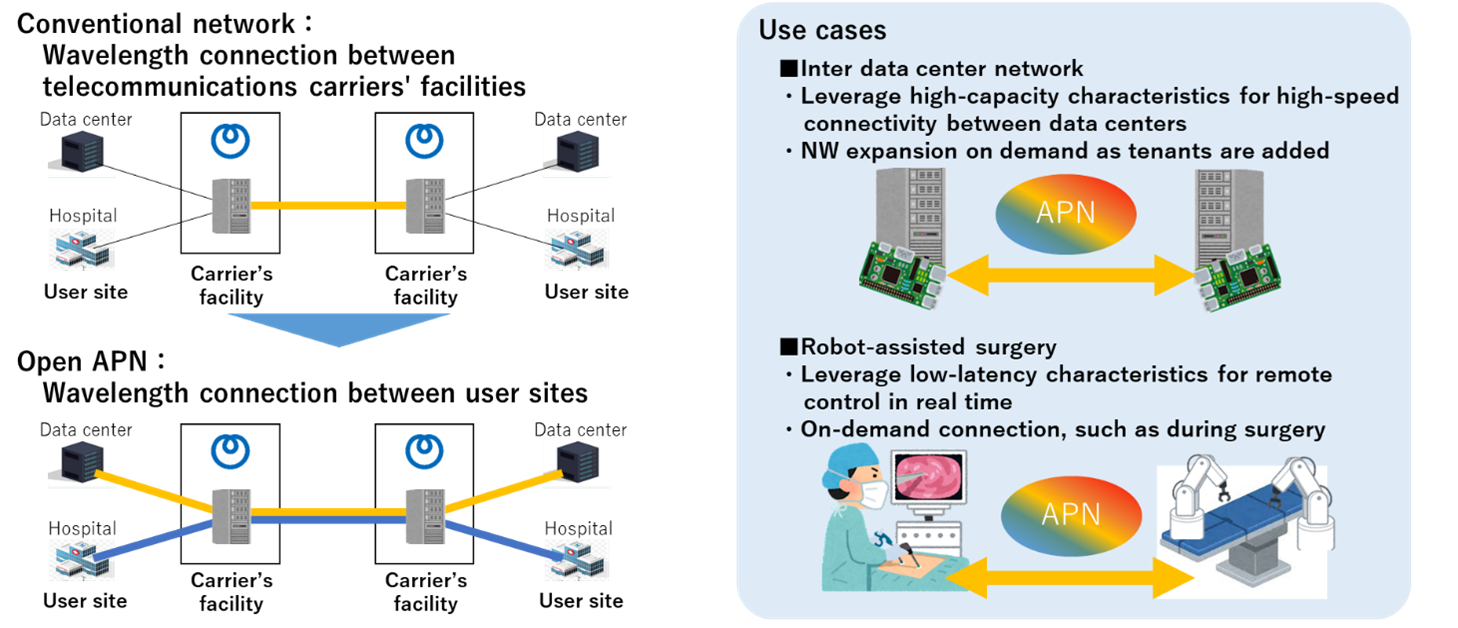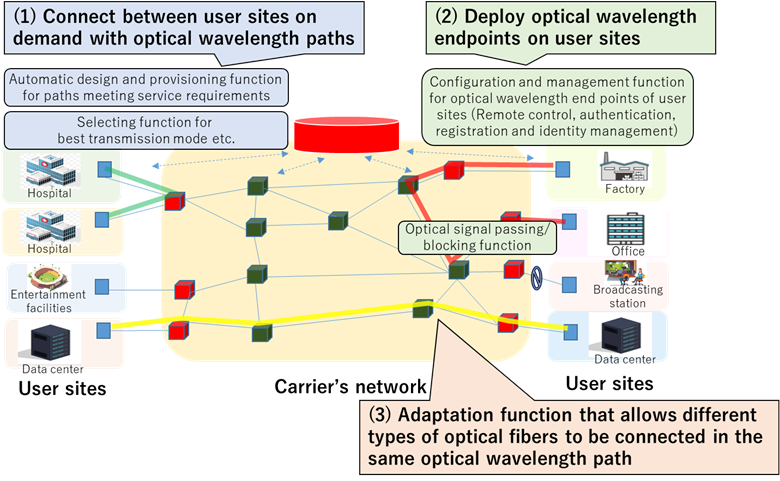Microsoft ends support for Internet Explorer on June 16, 2022.
We recommend using one of the browsers listed below.
- Microsoft Edge(Latest version)
- Mozilla Firefox(Latest version)
- Google Chrome(Latest version)
- Apple Safari(Latest version)
Please contact your browser provider for download and installation instructions.
November 14, 2022
NTT conducts an Open APN PoC jointly with global optical product vendors, conducts a field test of on-demand wavelength connection technologies,
and enhances its capability to develop photonics-electronics devices
Summary
- NTT Corporation (NTT), in collaboration with Ciena Corporation (Ciena), Fujitsu Limited (Fujitsu), and NEC Corporation (NEC), will conduct a joint PoC of Open APN1 defined by the IOWN Global Forum (IOWN GF)2.
- NTT will conduct a field test of its on-demand wavelength connection3 technologies to expand the application areas of APN.
- NTT will beef up its capability of developing photonic-electronic convergence devices by welcoming fJscaler Inc. as a subsidiary of NTT Electronics Corporation (NTT Electronics).
Background
Tokyo - December 14, 2022 - As society becomes increasingly information-oriented, AI and Internet of Things (IoT) technologies are being incorporated into our daily lives. The amount of data handled has been increasing rapidly, and data centers often reach their capacity limit, causing users to frequently connect new data centers with existing ones.
Also, robot-assisted surgery systems have started gaining traction. The operators of such systems want to make them remotely operable to train more surgeons and save more people. However, this requires high-speed and low-latency network connections.
Addressing the above demands, in January 2022, IOWN GF released the Open All Photonics Network (APN) Functional Architecture, which defines the functional architecture of a new network that creates high-speed and low-latency connections between communication endpoints. Data centers or hospitals may serve as communication endpoints, and this architecture leverages optical transport and switching technologies.
 Figure 1. Overview of Open APN and use cases
Figure 1. Overview of Open APN and use cases
Open APN Joint PoC
The network nodes defined in the Open APN Functional Architecture can be constructed from the Open ROADM MSA4's standard components, which are available from global optical product vendors such as Ciena, Fujitsu, and NEC. To prove the viability and operability of Open APN, NTT will conduct a PoC jointly with Ciena, Fujitsu, NEC, and other companies in the fourth quarter of fiscal 2022. The PoC will validate wavelength connection creation/deletion functions and evaluate the performance of optical communications in terms of throughput, delay, and jitter.
The PoC should prove that Open APN is implementable and operable with products already available in the global market and encourage many organizations in the world to build and implement Open APN.
Field Test of On-Demand Wavelength Connection Technologies
While conventional ROADM products are designed to create optical connections between telecommunication carriers' sites, an Open APN creates connections between all endpoints, including customer sites. This difference leads to the need for new functions as listed below (Figure 2):
 Figure 2. Functional requirements for on-demand wavelength connections between user sites
Figure 2. Functional requirements for on-demand wavelength connections between user sites
- A function for automatically designing and provisioning wavelength connections that satisfy service requirements by cooperation and coordination of terminals deployed in user sites and carrier equipment, and functions for selecting the best transmission mode, etc.
- A function for configuring and managing optical wavelength end points of terminals deployed in user sites and a function for passing and blocking optical signals in carrier equipment based on the authentication status of each terminal
- A function for adapting different types of optical fibers to be connected in the same optical wavelength5
NTT has developed the above functions and started a field test in the Tokyo metropolitan area. The test should validate their operability under various conditions, such as fiber length and loss levels in a real environment. As the test will also utilize the outcome from Open ROADM MSA and Telecom Infra Project Open Optical & Packet Transport6, it should demonstrate how the results from the three organizations can be combined to build open and disaggregated infrastructures.
NTT intends to incorporate the findings from the field test into future versions of IOWN GF Open APN Functional Architecture.
Enhancing capability to develop photonics-electronics devices
To promote high-capacity, low-latency, and energy-efficient communications with APN, NTT will beef up its capabilities of developing photonic-electronic convergence devices for products, including optical transceivers. As part of these efforts, NTT Electronics has made fJscaler Inc. (Oregon, USA), a company with extensive experience in high-performance analog integrated circuit design7its subsidiary.
Prospects
Future APNs will be capable of managing optical communication resources in cooperation with radio communication systems including 5G and beyond 5G. Due to NTT's ongoing efforts with IOWN GF members, APN will become the infrastructure for future societies, enabling high-capacity, low-latency, energy-efficient communications for both fixed and mobile devices.
1An innovative network based on photonics technology whose architecture is being openly developed at IOWN GF.
https://www.rd.ntt/iown/
2A new industry forum that promotes the realization of a new communication infrastructure consisting of all-photonics networks, including silicon photonics, edge computing, and wireless distributed computing through the development of new technologies, frameworks, technical specifications, and reference designs to meet the data and information processing demands of the coming era.
https://iowngf.org/
3A connection using a specific wavelength between optical transceivers. By occupying wavelengths between optical transceivers, low-latency and high-capacity communication are possible.
4A Multi-Service Agreement that defines the interfaces and specifications that allow ROADM (Re configurable Optical Add-Drop Multiplexer) systems to interoperate between vendors.
http://openroadm.org/
5A function for connecting multiple optical fibers with different wavelength bands without electrical conversion while remaining in the wavelength connection.
6A project aimed at defining open technologies, architectures, and interfaces in optical and IP networks.
https://telecominfraproject.com/oopt/
7https://www.ntt-electronics.com/en/news/2022/11/investment_in_fJscaler.html
About NTT
NTT believes in resolving social issues through our business operations by applying technology for good. An innovative spirit has been part of our culture for over 150 years, making breakthroughs that enable a more naturally connected and sustainable world. NTT Research and Development shares insights, innovations, and knowledge with NTT operating companies and partners to support new ideas and solutions. Around the world, our research laboratories focus on artificial intelligence, photonic networks, theoretical quantum physics, cryptography, health and medical informatics, smart data platforms, and digital twin computing. As a top 5 global technology and business solutions provider, our diverse teams operate in 80+ countries and regions and deliver services to over 190 of them. We serve over 80% of Fortune Global 100 companies and thousands of other clients and communities worldwide. For more information on NTT, visit https://www.rd.ntt/e/.
Media Contact
Press Relations
nttrd-pr@ml.ntt.com
Information is current as of the date of issue of the individual press release.
Please be advised that information may be outdated after that point.
NTT STORY
WEB media that thinks about the future with NTT










